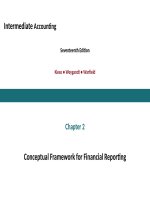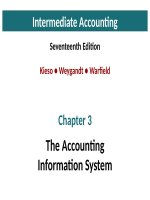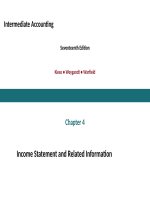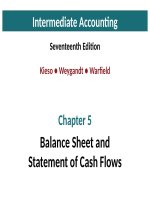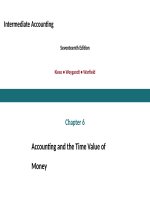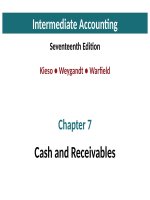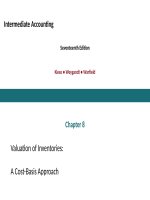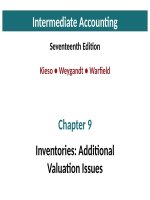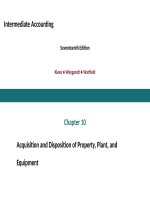Intermediate accounting 17e by kieso ch14
Bạn đang xem bản rút gọn của tài liệu. Xem và tải ngay bản đầy đủ của tài liệu tại đây (2.55 MB, 102 trang )
Intermediate Accounting
Seventeenth Edition
Kieso ● Weygandt ● Warfield
Chapter 14
Long-Term Liabilities
This slide deck contains animations. Please disable animations if they cause issues with your device.
Learning Objectives
After studying this chapter, you should be able to:
1.
Describe the nature of bonds and indicate the accounting for bond issuances.
2.
Describe the accounting for the extinguishment of debt.
3.
Explain the accounting for long-term notes payable.
4.
Indicate how to present and analyze long-term debt.
Copyright ©2019 John Wiley & Sons, Inc.
2
Preview of Chapter 14
Long-Term Liabilities
Bonds Payable
•
Issuing bonds
•
Types of bonds
•
Valuation and accounting
•
Effective-interest method
Copyright ©2019 John Wiley & Sons, Inc.
3
Preview of Chapter 14
Extinguishment of Debt
•
Economic substance
•
Illustration
Copyright ©2019 John Wiley & Sons, Inc.
4
Preview of Chapter 14
Long-Term Notes Payable
•
Notes issued at face value
•
Notes not issued at face value
•
Special situations
•
Mortgage notes payable
Copyright ©2019 John Wiley & Sons, Inc.
5
Preview of Chapter 14
Reporting and Analyzing Liabilities
•
Fair value option
•
Off-balance-sheet financing
•
Presentation and analysis
Copyright ©2019 John Wiley & Sons, Inc.
6
Learning Objective 1
Describe the Nature of Bonds and Indicate the Accounting for Bond
Issuances
LO 1
Copyright ©2019 John Wiley & Sons, Inc.
7
Bonds Payable
No explicit definition of a noncurrent (long-term) liability is provided in current GAAP.
Many therefore use the following approach:
“if does not meet the definition of a current liability, it must be long-term.”
LO 1
Copyright ©2019 John Wiley & Sons, Inc.
8
Bonds Payable
Issuing Bonds
•
Bond contract known as a bond indenture.
•
Represents a promise to pay a sum of money at designated maturity date, plus periodic
interest at a specified rate on the maturity amount (face value).
LO 1
•
Paper certificate, typically a $1,000 face value.
•
Interest payments usually made semiannually.
•
Used when amount of capital needed is too large for one lender to supply.
Copyright ©2019 John Wiley & Sons, Inc.
9
Bonds Payable
Types of Bonds
Common types found in practice:
LO 1
•
Secured and Unsecured (debenture) bonds.
•
Term, Serial, and Callable bonds.
•
Convertible, Commodity-Backed, Deep-Discount bonds.
•
Registered and Bearer (Coupon) bonds.
•
Income and Revenue bonds.
Copyright ©2019 John Wiley & Sons, Inc.
10
Types of Bonds
Corporate bond listing.
LO 1
What do the numbers mean?
Copyright ©2019 John Wiley & Sons, Inc.
11
Valuation and Accounting for Bonds Payable
Issuance and Marketing of Bonds to the public
LO 1
•
Usually takes weeks or months.
•
Issuing company must
Arrange for underwriters.
Obtain SEC approval of bond issue, undergo audits, and issue a prospectus.
Have bond certificates printed.
Copyright ©2019 John Wiley & Sons, Inc.
12
Valuation and Accounting for Bonds Payable
Selling Price of a Bond Issue set by the
•
supply and demand of buyers and sellers,
•
relative risk,
•
market conditions, and
•
state of the economy.
Investment community values a bond at the present value of its expected future cash flows,
which consist of (1) interest and (2) principal.
LO 1
Copyright ©2019 John Wiley & Sons, Inc.
13
Valuation and Accounting for Bonds Payable
Interest Rate
•
•
Stated, coupon, or nominal rate = Rate written in the terms of the bond indenture.
Bond issuer sets this rate.
Stated as a percentage of bond face value (par).
Market rate or effective yield = Rate that provides an acceptable return commensurate with
issuer’s risk.
LO 1
Rate of interest actually earned by bondholders.
Copyright ©2019 John Wiley & Sons, Inc.
14
Valuation and Accounting for Bonds
How do you calculate the amount of interest that is actually paid to the bondholder each period?
(Stated Rate × Face Value of the Bond)
How do you calculate the amount of interest that is actually recorded as interest expense by
the issuer of the bonds?
(Market Rate × Carrying Value of the Bond)
LO 1
Copyright ©2019 John Wiley & Sons, Inc.
15
Valuation and Accounting for Bonds
Assume Stated Rate of 8%
LO 1
Copyright ©2019 John Wiley & Sons, Inc.
16
Valuation and Accounting for Bonds
Illustration
ServiceMaster Company issues $100,000 in bonds, due in five years with 9 percent interest payable
annually at year-end. At the time of issue, the market rate for such bonds is 11 percent.
LO 1
Copyright ©2019 John Wiley & Sons, Inc.
17
Valuation and Accounting for Bonds
Time Diagram for Bond Cash Flows
Present value of the principal: $100,000 × .59345 (Table 6.2)
Present value of the interest payments: $9,000 × 3.69590 (Table 6.4)
Present value (selling price) of the bonds
LO 1
$59,345.00
33,263.10
$92,608.10
Copyright ©2019 John Wiley & Sons, Inc.
18
Bonds Issued at Par on Interest Date
Illustration: Buchanan Company issues at par 10-year term bonds with a par value of $800,000, dated
January 1, 2020, and bearing interest at an annual rate of 10 percent payable semiannually on January 1
and July 1, it records the following entry.
Journal entry on date of issue, Jan. 1, 2020.
Cash
800,000
Bonds Payable
LO 1
800,000
Copyright ©2019 John Wiley & Sons, Inc.
19
Bonds Issued at Par on Interest Date
Interest
Journal entry to record first semiannual interest payment on July 1, 2020.
Interest Expense
40,000
Cash
40,000
Journal entry to accrue interest expense at Dec. 31, 2020.
Interest Expense
40,000
Interest Payable
LO 1
40,000
Copyright ©2019 John Wiley & Sons, Inc.
20
Bonds Issued at Discount on Interest Date
Illustration: If Buchanan Company issues $800,000 of bonds on January 1, 2020, at 97, and bearing
interest at an annual rate of 10 percent payable semiannually on January 1 and July 1, it records the
issuance as follows.
Cash ($800,000 × .97)
776,000
Discount on Bonds Payable
24,000
Bonds Payable
800,000
Note: Assuming the use of the straight-line method, $1,200 of the discount is amortized to interest expense each period for 20
periods ($24,000 ÷ 20).
LO 1
Copyright ©2019 John Wiley & Sons, Inc.
21
Bonds Issued at Discount on Interest Date (continued)
Illustration: Buchanan records the first semiannual interest payment and the bond discount on July 1, 2020,
as follows.
Interest Expense
41,200
Discount on Bonds Payable
1,200
Cash
40,000
Buchanan makes the following adjusting entry (12/31/20).
Interest Expense
41,200
Discount on Bonds Payable
1,200
40,000
Interest Payable
LO 1
Copyright ©2019 John Wiley & Sons, Inc.
22
Bonds Issued at Premium on Interest Date
Illustration: If Buchanan Company issues $800,000 of bonds on January 1, 2020, at 103, and bearing
interest at an annual rate of 10 percent payable semiannually on January 1 and July 1, it records the
issuance as follows.
Cash ($800,000 x 1.03)
824,000
Premium on Bonds Payable
24,000
Bonds Payable
800,000
Note: With the bond premium of $24,000, Buchanan amortizes $1,200 to interest expense each period for 20 periods ($24,000
÷ 20).
LO 1
Copyright ©2019 John Wiley & Sons, Inc.
23
Bonds Issued at Premium on Interest Date (continued)
Illustration: Buchanan records the first semiannual interest payment and the bond premium on July 1, 2020,
as follows.
Interest Expense
38,800
Premium on Bonds Payable
1,200
Cash
40,000
Buchanan makes the following adjusting entry (12/31/20).
Interest Expense
38,800
Premium on Bonds Payable
1,200
40,000
Interest Payable
LO 1
Copyright ©2019 John Wiley & Sons, Inc.
24
Bonds Issued Between Interest Dates
When companies issue bonds on other than the interest payment dates,
•
Buyers will pay the seller the interest accrued from the last interest payment date to the date
of issue.
•
On the next semiannual interest payment date, purchasers will receive the full six months’
interest payment.
LO 1
Copyright ©2019 John Wiley & Sons, Inc.
25
